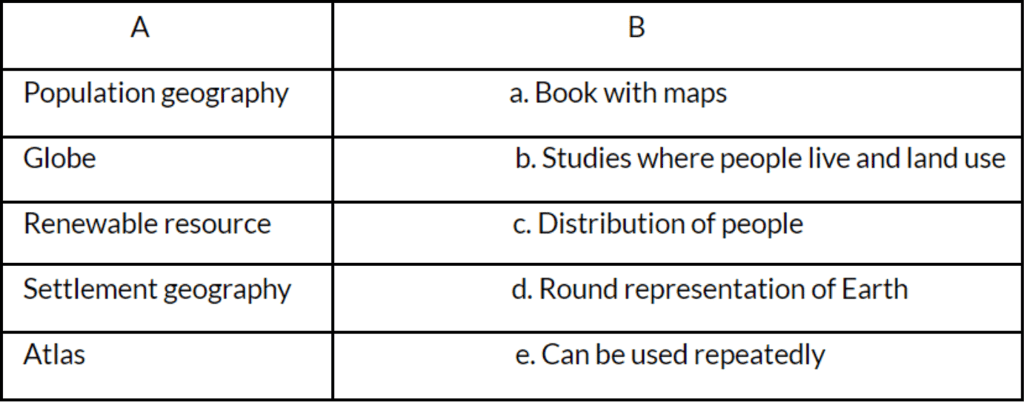Worksheet: What is Geography | Social Studies for Grade 7 PDF Download
| Table of contents |

|
| Multiple Choice Questions (MCQs): |

|
| Fill in the Blanks: |

|
| True/False: |

|
| Match the Following |

|
Multiple Choice Questions (MCQs):
Q1: What is the primary focus of Physical Geography?
A: Study of landforms, climate, and natural resources.
B: Study of population distribution and migration patterns.
C: Study of economic activities and industries.
D: Study of settlements and land use in cities.
Ans: A
• Physical Geography deals with the study of natural features like landforms, climate, atmosphere, and natural resources on Earth.
• It examines the physical aspects of the Earth's surface, including its terrain, soil, vegetation, and weather patterns.
• Concepts like landforms, climate, and natural resources fall under the domain of Physical Geography.
Q2: What is the main objective of Human Geography?
A: To study the distribution and movement of people across different regions.
B: To analyze the Earth's atmospheric conditions and climate patterns.
C: To examine the formation and characteristics of different landforms.
D: To explore the renewable and non-renewable natural resources on Earth.
Ans: A
• Human Geography focuses on studying the spatial distribution and patterns of human populations.
• It investigates how people interact with their environment and how they settle in different regions.
• Topics like population distribution, migration, settlements, and economic activities are covered under Human Geography.
Q3: What is the primary concern of Environmental Geography?
A: To study the Earth's physical features and their formation processes.
B: To analyze the impact of human activities on the environment and natural resources.
C: To investigate the economic factors influencing the distribution of industries.
D: To examine the cultural aspects and lifestyles of different populations.
Ans: B
• Environmental Geography deals with the study of the environment and its components.
• It focuses on understanding the interactions between the physical environment and human activities.
• It examines how human actions affect the environment, natural resources, and their management.
Q 4: Which tool is used to accurately represent the entire Earth's surface?
A: Map
B: Atlas
C: Globe
D: Satellite imagery
Ans: C
• A globe is the most accurate representation of the Earth's spherical shape.
• Maps and atlases, being flat surfaces, cannot accurately depict the entire Earth without distortions.
• A globe provides a three-dimensional and accurate representation of the Earth's surface and its features.
Q5: What is the purpose of using graphs in Geography?
A: To locate and identify specific places on maps.
B: To study the cultural traditions and customs of different regions.
C: To visually represent and analyze geographic data and relationships.
D: To explore the historical events and their impact on various locations.
Ans: C
• Graphs are used in Geography to visually represent and analyze geographic data and relationships.
• They help to clearly depict information and demonstrate connections between different geographic factors.
• Graphs are effective tools for describing situations, analyzing trends, and understanding patterns related to geographic concepts.
Fill in the Blanks:
Q1 The study of the distribution and movement of people across the world is known as __________ geography.
Ans: Population geography.
Q2 The most accurate way to represent the Earth’s shape is with a __________.
Ans: Globe.
Q 3 Renewable resources, like __________, can be used repeatedly without depletion.
Ans: Rainfall.
Q4 The __________ is the layer of air that surrounds the Earth and is crucial for weather and climate.
Ans: Atmosphere.
Q5 Graphs in geography help analyze connections and are created using __________, which can be primary or secondary.
Ans: Data.
True/False:
Q1 Human geography only studies the distribution of people around the globe.
Ans: False.
- Human geography also examines migration, settlement growth, and economic activities.
- It considers the quality of life and environmental impact.
Q2 The atmosphere is a layer of water surrounding the Earth.
Ans: False.
- The atmosphere is actually a layer of air, not water.
- It’s essential for weather and climate.
Q 3 Soil is formed from broken rocks and supports plant growth around the Earth.
Ans: True.
- Soil is indeed derived from weathered rocks.
- It provides a medium for plants to grow.
Q4 An atlas is a collection of songs from around the world.
Ans: False.
- An atlas is a book containing maps, not songs.
- It helps locate places on Earth.
Q5 Non-renewable resources, like coal, can be used over and over again.
Ans: False.
- Non-renewable resources, such as coal, have a limited supply.
- Once used, they cannot be replenished.
Match the Following

Answer: 1 - c, 2 - d, 3 - e, 4 - b, 5 - a
- Population geography (1) is concerned with the distribution of people .
- A globe (2) is a round representation of Earth (d), showing its true shape.
- A renewable resource (3) is one that can be used repeatedly (e), like solar energy or wind.
- Settlement geography (4) studies where people live and how land is used in urban areas (b).
- An atlas (5) is a book with maps (a) that helps in locating different places on Earth.
|
94 docs|11 tests
|
FAQs on Worksheet: What is Geography - Social Studies for Grade 7
| 1. What is geography? |  |
| 2. Why is geography important? |  |
| 3. What are the different branches of geography? |  |
| 4. How does geography help us in our daily lives? |  |
| 5. What are some career options for someone studying geography? |  |















